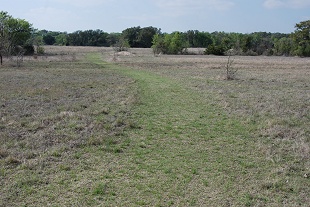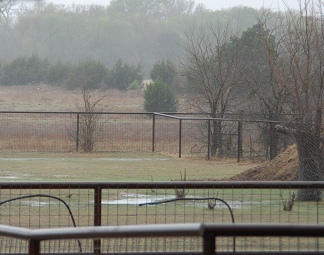Mar 16
Posted: under Activities, Plantlife, Water, Weather.
Tags: beauty, observation, photography, water resource management, Weather March 16th, 2009
Plants around here take immediate advantage of water, so the change in color after less than a week from the first drop of rain is striking. Not only does green show on the mowed maintenance path, but at the base of the taller clumps to either side. Rain started Wednesday; this was taken Sunday. Last […] [...more]
Plants around here take immediate advantage of water, so the change in color after less than a week from the first drop of rain is striking.

Near Meadow
Not only does green show on the mowed maintenance path, but at the base of the taller clumps to either side. Rain started Wednesday; this was taken Sunday. Last week, no green.
Read the rest of this entry »

Mar 13
Posted: under Water, Weather.
Tags: drought, rain, Weather March 13th, 2009
We hit the jackpot this time. Before dark today, Richard recorded a storm total (over three days ) of 4 inches at Owl Pavilion, 3.7 at Fox Pavilion. The two house gauges, one north of our house and one west of the other house, were measured at roughly noon, both over 3 inches. This is […] [...more]
We hit the jackpot this time. Before dark today, Richard recorded a storm total (over three days ) of 4 inches at Owl Pavilion, 3.7 at Fox Pavilion. The two house gauges, one north of our house and one west of the other house, were measured at roughly noon, both over 3 inches.

This is a shot from the end of the front porch, across the barn pen fence, into the south horse lot, about four Friday afternoon. Puddles!!! Green!!! (that field was gray-tan three days ago. Our grass is ambitious.)
Read the rest of this entry »

Mar 11
Posted: under Water, Weather.
Tags: Weather March 11th, 2009
Last night the front blew in. I was awake with a cramp (one of those you get up and loosen, think is gone, lie down, and it comes back) and all the windows were open–it had been near 80 in the day and was still in the 70s when we went to bed. So I […] [...more]
Last night the front blew in. I was awake with a cramp (one of those you get up and loosen, think is gone, lie down, and it comes back) and all the windows were open–it had been near 80 in the day and was still in the 70s when we went to bed. So I was muttering to the cramped muscle, when a little trickle of cool air came in the NE window. Cold fronts here send scouts slithering under the warm air masses, lifting their skirts, as it were, testing to see if the warm air mass can be moved, before the real wind starts. The front wasn’t supposed to arrive that soon, but nothing that cool had been around for weeks.
Then I heard it in the distance, an advancing roar. The curtain fluttered, then lifted out into the room an inch or so. The roar came nearer; the hall bathroom window shade banged on the frame, and I scuttled around in the dark shutting all the north-side windows, and smelling what I hoped was rain on the wind.
Read the rest of this entry »

Dec 08
Posted: under Water, Weather.
Tags: drought December 8th, 2008
Our area is at least sixteen inches below average annual rainfall this year–that’s means we’ve had less than half the average. The “at least” is because what rain we’ve had has been spotty–one place might get four inches and another none, from the same weather system. In addition to the lack of rainfall, aquifers and […] [...more]
Our area is at least sixteen inches below average annual rainfall this year–that’s means we’ve had less than half the average. The “at least” is because what rain we’ve had has been spotty–one place might get four inches and another none, from the same weather system.
In addition to the lack of rainfall, aquifers and reservoirs both are sinking. One of our town’s four wells isn’t producing at all, and the other three are pumping less than normal. A development-friendly county government has supported rapid growth, both residential and commercial, with the predictable (but not to them) growth in demand for water…hence many new wells, all tapping the same resource…shallow wells tapping the groundwater that used to supply springs and small creeks in dry years, and deep wells (to Trinity Sands, the main deep aquifer) for “permanent” water. Creeks and springs–even one river–have dried up completely in the past year.
From the land manager’s perspective, rainfall is THE water resource in this part of the world. We have two “rain barns” to collect and store rainwater (and are working on another–trusses for its roof are finished and being painted.) This stored water provides permanent (we hope) water for wildlife at three different sites and each site is optimized for a different use.
Wildlife (and re-introduction of native plants to improve natural food supplies and habitat) must have reliable water. This year, it was all we could do to keep the wildlife supply going. We lost approximately 90% (maybe more–we’ll know next spring) of the past two years’ worth of plantings because we could not provide enough water…what we could provide, we allocated to a few of the plantings easiest to reach with a bucket.
But if it doesn’t rain…there’s nothing to collect. I designed the collection area/storage capacity for a little below the previously recorded worst-case–ten inches a year–but that’s where we are right now.
The bright spot in this is the response of the original (and re-introduced) natives that didn’t croak. The deep-rooted tallgrass dominants stayed green: big bluestem, switchgrass, Indiangrass, little bluestem, even eastern gama (the water lover of the bunch) are all fine (so far.) Up on the dryest area (a rocky knoll with very thin soil, if any) some didn’t make it–even agarita, which normally grows out of rock anyway–but some did. We have more two-leaved senna and partridge pea than before. We have a new odd milkweed (the experts are still arguing over it.) The Mirabilis alba and Pitcher Sage have both spread this year, and the Maximilian Sunflower, though less than half the height in an average year, has continued to spread sideways in its clumps.



